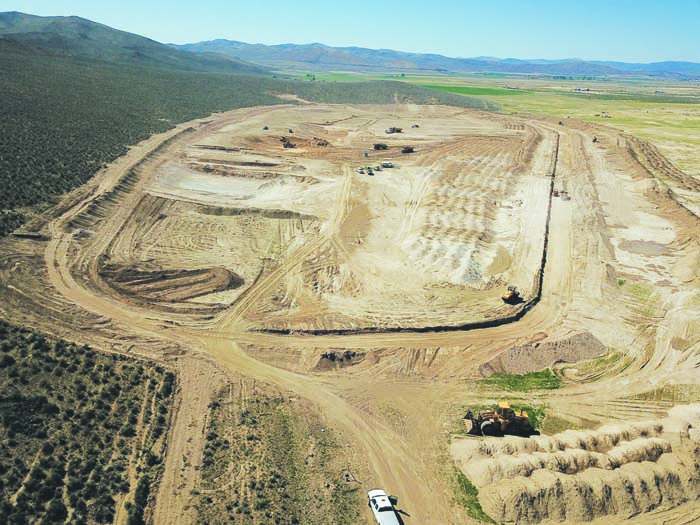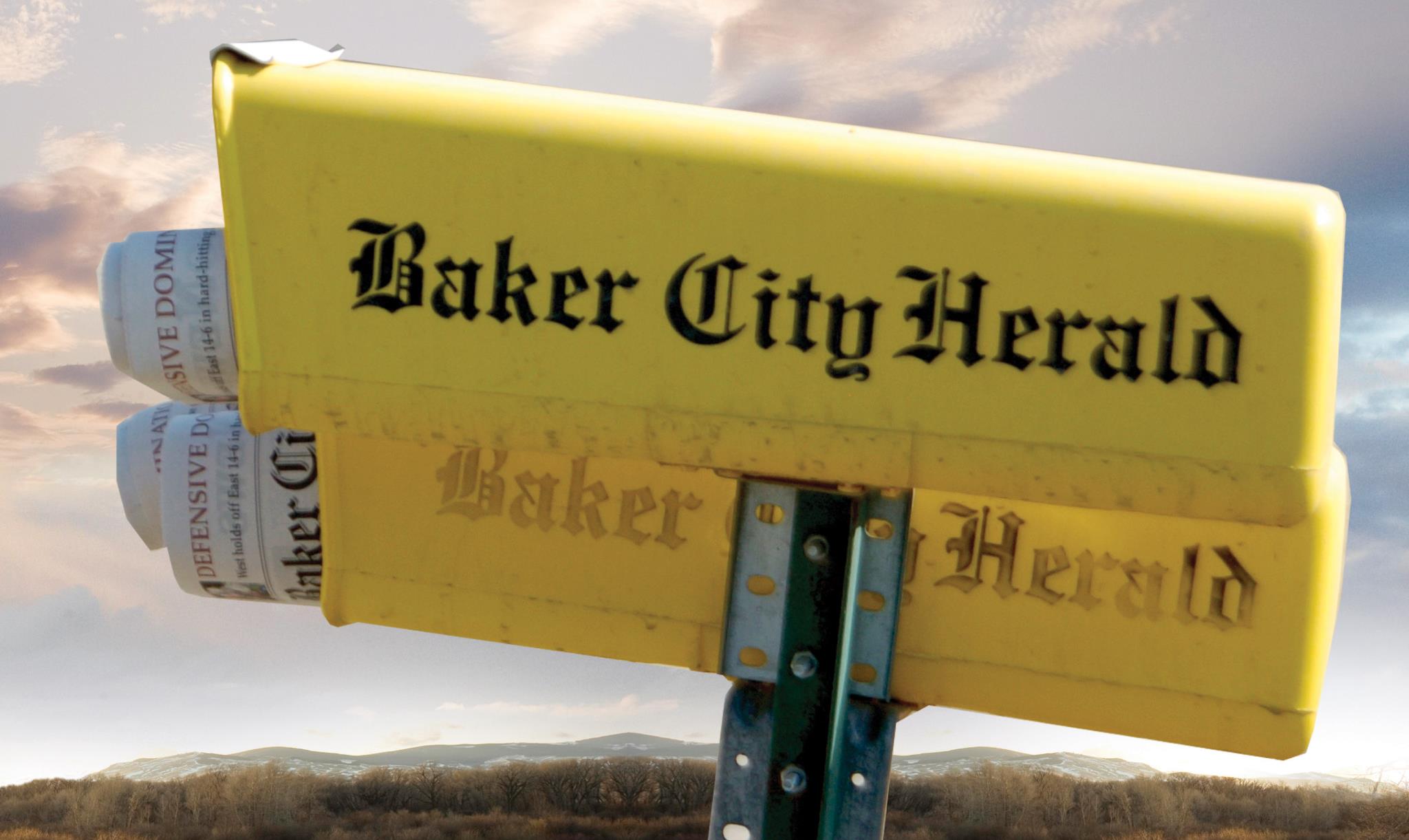Liner leaking at Baker City’s new wastewater lagoon
Published 10:08 am Thursday, August 24, 2023

- This view from a drone shows Baker City's wastewater lagoon under construction in Baker Valley in 2021.
Baker City officials are dealing with two problems with the city’s wastewater disposal system, one involving the $5.7 million project, completed in 2021, to build a new pipeline and storage lagoon.
Joyce Bornstedt, the city’s public works director, told city councilors during their work session Tuesday, Aug. 22 that “it’s just not a very pleasant situation.”
Leaking liner
The liner in the new storage lagoon, at the eastern edge of Baker Valley just south of Highway 203, is leaking, Bornstedt told councilors Tuesday.
She said city workers started seeing bubbles in the pond last spring while it was being filled for the first time.
The liner was installed in the fall of 2021.
The problem has worsened, and for the past several months city officials have been working with the project’s contractor, Gyllenberg Construction of Baker City, to drain the pond so the liner can be repaired, Bornstedt said.
Mayor Beverly Calder said city officials have been meeting with the contractor as well as officials from the company that made the liner. She said the source of the leaks can’t be determined until the lagoon is drained.
Bornstedt told councilors that the contractor is responsible for the costs of the draining, as well as repairs and any fines the city might incur from regulatory agencies.
Brent Gyllenberg of Gyllenberg Construction declined to comment on Thursday, Aug. 24.
The new lagoon, on a 51-acre parcel the city bought in 2019 for $123,000, is much deeper, at about 20 feet, than the four lagoons built in the early 1960s about one mile north of town, and thus has a greater capacity. The older lagoons are 6 to 8 feet deep.
The city began the project, one of the most expensive in the past couple decades, after the Oregon Department of Environmental Quality (DEQ) mandated that the city eventually cease piping treated wastewater into the Powder River.
The DEQ is monitoring work on the lagoon liner, and the agency has not issued any penalties to the city, DEQ spokesman Harry Esteve said in an email reply Thursday, Aug. 24 to questions from the Baker City Herald.
In 2017, the city entered into a Mutual Agreement and Order (MAO) with DEQ that required the city to pursue a modification to the wastewater treatment process.
City officials decided to build the new lagoon, and construct a pipeline connecting the old lagoons to the new pond, which is about 7 miles away.
In November 2020 the City Council agreed to have the city borrow as much as $7.5 million from the state to pay for the wastewater project. The city will repay the loan over 30 years with a 1.36% annual interest rate. Because the contract with Gyllenberg Construction was for about $5.7 million, the city didn’t need to borrow the full amount.
Bornstedt told councilors Tuesday that the city might need to borrow more money, however, to deal with another wastewater issue — what to do with the tens of millions of gallons of treated wastewater.
Where to put the wastewater?
Bornstedt said the DEQ denied the city’s application to use treated wastewater from the new lagoon to irrigate non-food crops on private property adjacent to the lagoon, a vital part of the city’s plan for its wastewater system.
That denial created “quite a quandary” for the city, Bornstedt told councilors Tuesday.
Calder said the DEQ had initially given the city permission to use treated wastewater from the lagoon for irrigation on the property adjacent to the lagoon. She said agency officials earlier this year withdrew that permission, citing issues related to the mineral composition of the soil that made it less than ideal for irrigation with the treated wastewater.
Bornstedt said the city is looking at three other sites for irrigation, but none is adjacent to the lagoon, and each would require the city to build a new pipeline, for an unknown cost.
Calder credited Bornstedt with working quickly to meet with landowners who are interested in using the treated wastewater for irrigation.
“She’s doing an amazing job getting other options in play,” Calder said.
Esteve, the DEQ spokesman, said the city’s initial plan to use wastewater to irrigate crops “did not meet Oregon’s recycled water land application requirements for all the selected sites.”
Some of those sites have a shallow groundwater table as well as soils that are acidic and that don’t readily absorb water.
“Their geography puts groundwater and surface water at risk for contamination if there were to be land application outside what is approved in the revised plan,” Esteve said.
In a March 20, 2023, letter to State Sen. Lynn Findley, the Vale Republican who represents Baker County in the Oregon Legislature, Brandon Mahon of Anderson Perry & Associates, the La Grande firm the city hired to help design the new wastewater system, addressed the DEQ’s partial denial of the city’s plan to irrigate with wastewater from the new lagoon.
Mahon wrote that the DEQ had made “several revisions” to the city’s plan, and that the agency prohibited the city from using two center pivot irrigation systems due to “poor soil conditions” on the land.
“The City has been trying to evaluate and discuss compromises with DEQ, but all items that have been suggested have resulted in a firm ‘no’ from the agency,” Mahon wrote. “We need your help.”
Mahon wrote that if the city can’t use those two pivots, it won’t be able to use enough wastewater for irrigation to keep the lagoon’s level at acceptable levels “and ultimately make it through the winter” — the period when irrigation isn’t needed because no crops are growing.
Record rain exacerbates city’s challenge
While the new lagoon is being drained to facilitate an inspection and repairs to the liner, the city has been pumping wastewater from the new lagoon back through the pipeline to the old lagoon. From there the city had been diverting the treated wastewater into the nearby Powder River — the method of disposal the city has used for several decades. Bornstedt told councilors the city is still permitted to pipe the treated wastewater into the river.
However, the concentration of E. coli bacteria in the water recently exceeded the allowed limit, forcing the city to temporarily stop releasing water, Bornstedt said. The same thing happened in March 2022, forcing the city to stop releasing water into the river for about two weeks.
Esteve said the city is permitted to pipe treated wastewater into the river so long as the water doesn’t exceed E. coli limits.
The old lagoons are nearing their capacity now, and are about two weeks from reaching that limit, Bornstedt told councilors Tuesday.
The record-breaking rainfall on Monday, Aug. 21 exacerbated the situation, she said, adding about 2 million gallons of wastewater to the system.
“It’s a very difficult situation,” Bornstedt said.
Calder said she’s not sure when the city will be able to resume releasing water from the old lagoons into the river.
Bornstedt told councilors the goal is to drain the new lagoon before winter arrives so the liner can be repaired and wastewater can again be piped from the treatment facility, which is near the old lagoons, to the new lagoon.




